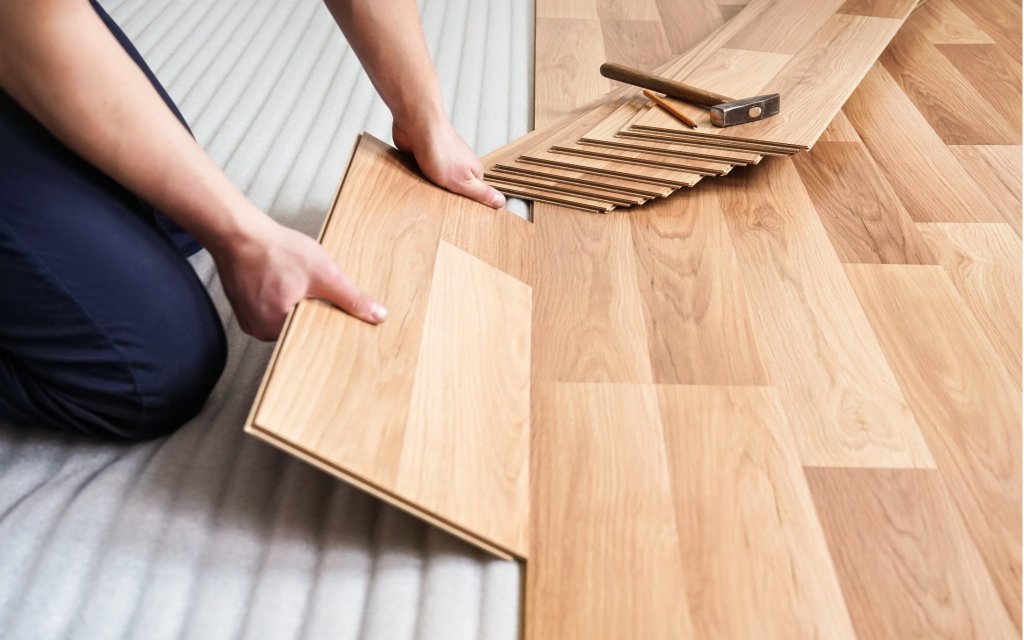You’ve decided to remodel your floors and you’re trying to decide between laminate and hardwood flooring. You know you can get a similar look from either one, but you’re not sure which one is a better option for your project. The experts at Hardwood Planet know this is a difficult choice and want to make it easier by explaining the differences between these two excellent flooring options.
Material
As you might expect, hardwood flooring is made of solid hardwood material throughout each board. The individual boards are typically 3/4-inch thick and are manufactured to have a smooth top surface and tongue-and-groove interlocking edges. Sometimes the boards are unfinished and must be stained and varnished after they’ve been installed, but it’s becoming more popular to purchase hardwood boards already finished so this extra step isn’t required.
Laminate flooring, on the other hand, consists of a fiberboard core that is manufactured from wood byproducts. A layer that is designed to resemble hardwood or other material is affixed on top of the core. Then, a clear layer of protectant is applied on top of the design to make it more resistant to stains and scuffs. Laminate boards are between 1/4- and 1/2-inch thick and are manufactured with click-lock edges to make installation easier.
The Installation Process
The installation process for hardwood floors involves blind-nailing each board to the subfloor. The nails are typically inserted through the tongue part of the tongue-and-groove edge that interlock to keep the boards together. Some boards do not have this tongue-and-groove edge and must be nailed through the boards themselves. Subfloors vary, but experts recommend covering your floor with a moisture inhibitor like a silicone vapor shield or an asphalt-saturated felt to prevent your boards from warping.
Laminate flooring can be installed in several ways, irrespective of the colors of your walls. The first is known as a floating floor, which means it isn’t nailed or glued down at all. The laminate panels are click-locked together and put down over the subfloor. Even though laminate is not as susceptible to warping as real wood, it’s advised that you still put down a moisture inhibitor to protect your floors and subfloors from spills. Glue is also a popular installation method for laminate floors, especially if you’re covering a concrete subfloor.
Appearance
Most people would agree that hardwood floors are attractive and provide a premium appearance that complements living room design ideas with brown sofas, enhancing the cohesive look between the floor and furniture. Laminate floors can look like wood from a distance, but you can usually tell they are manufactured and not real wood when you get close. However, many high-end laminate products look fabulous and you can get the look of any material you want, from stone to brick to wood. You can also ensure you get a product that perfectly matches any color scheme, which can be difficult with real wood.
Water Resistance
In most cases, you should not put hardwood floors in rooms that see a lot of moisture because they just aren’t designed to withstand water. This is why bathrooms, kitchens, and even basements are not great places for real hardwood floors. The boards will eventually warp and no longer fit the way they should. Floods will damage the boards and you will need to replace them individually as this happens. And, it can be difficult to find individual boards that match the rest of your floor, especially years down the road.
Laminate flooring withstands water and moisture much better than real hardwood flooring, but they are still not recommended for places that get a lot of moisture because it can get between the joints and cause the fiberboard core to swell. You can seal the joints, but you will need to repeat the process every so often to keep its water-resistant qualities. If you have to choose between wooden and laminate floors for a bathroom, kitchen, or basement, laminate is the right choice, but know that you will still run the risk of warping.
Heat Resistance
Both hardwood and laminate flooring can be installed over radiant heating systems, but hardwood floors can shrink when overheated. Laminate floors do not have this problem, so it is recommended that if you have a radiant heat system in your floors, you should use laminate flooring instead of real hardwood flooring to prevent the boards from shrinking. However, the boards will expand again when the temperature is lowered, so if you can handle them shrinking with the heat, the boards themselves will not be damaged.
Durability and Maintenance
Hardwood floors are more durable than laminate floors, but both will last long. If either gets damaged by water, you will need to replace individual boards or the entire floor, depending on the severity. Both types of flooring are simple to maintain these days, and just require sweeping, vacuuming, and mopping with a special cleaning formula designed for hardwood or laminate floors.
Conclusion
Weighing the pros and cons of laminate versus hardwood floors often concerns aesthetic preferences and cost considerations. Hardwood floors, for example, pair beautifully with accent wall design ideas, enhancing the overall look of spaces like living rooms with their natural charm and warmth.
It comes down to appearance and/or cost, since hardwood floors are more expensive than laminate floors and will compliment the brown couch in the living room. Just be sure to take the time to consider each type of flooring carefully so you get a product you’re happy with.

